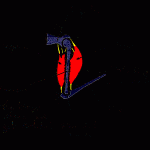Striped muscle is furthermore called voluntary muscle. It is sometimes called striped muscle because this is what it appears like through a microscope. It is also called voluntary muscle because this is the muscle, which you have unswerving control over when you fancy to build a movement. You may also be informed that it is called skeletal muscle; this is because it is attached to the skeleton. You can utilize any one of these names.
Striped muscle is the muscle (or meat) on you legs arms etc.; you have undeviating control over these muscles and can make almost any movements, which you would like to. These muscles are also originated in your face and jaws, so they are used when you smile or frown and when you talk, eat or drink.

Striped muscles are always initiated in pairs of antagonistic muscles. A pair of muscles, the biceps and triceps, are worned to bend and straighten the elbow. When you craft your biceps contract, it flexes the elbow (bends it). When you contract your triceps, it expands the elbow (straightens it). The elbow, which is a hinge joint, only desires one pair of muscles to build it work, but your shoulder, which is a ball and socket joint, requires three pairs of muscles. This is because a ball and socket joint can construct three kinds of movement. Your arm can be stimulated forwards and backwards at the shoulder; it can also be stirred sideways up and away form your body and back down to your side; thirdly, you can twirl your arm round. In this third movement you can formulate the palm of your hand point down or backwards and up and forwards. Some of this twisting occurs at the shoulder, but some of the twisting happens in your forearm.
Smooth Muscle
This is called smooth or involuntary muscle. It is called smooth muscle because you cannot observe any stripes when you stare at it through the microscope; it is also called involuntary muscle because you cannot craft it contract and relax through cognizant control. Smooth muscle contracts and relaxes robotically. This muscle is found in your intestines and in the iris of your eye. When you acquire a mouthful of food, soft muscles in your salivary gland squeeze the gland so that saliva squirts into your mouth. Sometimes the muscles clutch the salivary gland so strongly that it hurts. If you sink your teeth into a sour apple, you experience a pain at the back of your jaw just beneath your ear.
The muscles in your intestines also work in pairs. When the circular muscles contract they build the intestines longer (and thinner) and when the longitudinal muscles contract they create the intestines shorter (and fatter). These muscles shift food along the guts (peristalsis) and assist to mix food with your digestive juices.
Cardiac Muscle
The muscle of your heart is also striped but it is unintentional. It is called cardiac muscle: cardiac means “of the heart”. Cardiac muscle contracts and relaxes robotically without you having to reflect about it.
Antagonistic Muscles
The entire muscles exert in pairs. Whether they are striped muscle, smooth muscle or cardiac muscle makes no difference, all muscles must exert in pairs. This is because they can contract and relax but cannot shove or stretch themselves.
At the same time it also pulls the triceps to make it longer. So the biceps pulling it stretches the triceps. When the triceps contracts or extends (straightens) the elbow joint, and at the equivalent time it pulls the biceps and makes it longer. So these two muscles work together.



